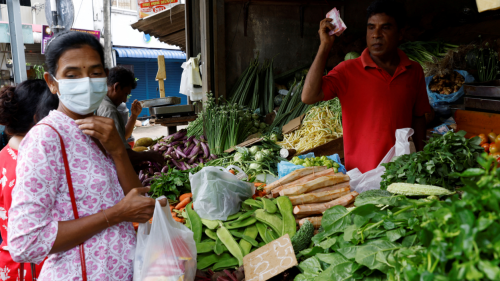Agricultural Investment: Foreign Aid for Global Prosperity

Activities to support resilient livelihoods must be combined with peacebuilding, conflict resolution efforts, and investment in food security.
High global food prices and the disruption of the global food supply chain due to the war in Ukraine could trigger riots and violent conflicts among those going hungry in low- to middle-income countries.
One in ten people in the world do not have enough to eat, while millions have been pushed into poverty and hunger by the impact of extreme weather events and the fallout of the COVID-19 pandemic. The continuation of this conflict, already a tragedy for those directly involved, will be catastrophic for the entire world, particularly those already struggling to feed their families.
It is time for governments, development organizations, military, and intelligence communities to broaden their definitions of “security”—and serve to emphasize that one of the best investments we can make in global stability and prosperity is to help people who can’t feed themselves or their families.
Food Insecurity as a Harbinger for and Result of Conflict
Food insecurity, defined as a lack of consistent access to adequate food, affects the lives of millions of people across the world. Almost 60 percent of the world’s 811 million hungry people live in areas affected by armed violence, including Somalia, Ethiopia, Nigeria, South Sudan, the Central African Republic, Mozambique, Syria, and Yemen. The list goes on.
The unchallenged consensus is that war and conflict are development issues: conflict ravages local economies, often leading to forced migration and disease outbreaks, the collapse of social trust, and acute food insecurity.
But food insecurity isn’t just an outcome of conflict—it also contributes to causing it.
Causal and substantive links exist between food security and violent conflict, spanning from individual to global levels. Known as the “conflict trap,” food insecurity is often the “straw that breaks the camel’s back” in fragile countries. Hunger produces desperation that causes communities to act on existing grievances, cleaving society along pre-established lines.
The relationship between conflict and food security often creates a vicious cycle as food scarcity leads to market disruptions, which leads to further decreases in food availability and greater disruption. Rising food prices contribute to food insecurity, which is a clear and serious threat to human security. Food insecurity, especially when caused by higher food prices, heightens the risk of democratic breakdown, civil conflict, protest, rioting, and communal conflict. Climate shocks can have similar impacts on food security. However, persistent conflicts, climate shocks, and food insecurity have driven millions of people to migrate away from their communities. Many forcibly displaced people become refugees. According to the United Nation World Food Program Report, in 8 out of 10 of the worst hunger crises, conflict is one of the main drivers. The 2022 Global Report on Food Crisis also confirms that conflict remains the main driver of food insecurity.
International Solidarity and Cooperation Necessary to End Hunger
The effects of food insecurity on human security are dire, as are the consequences for political stability and conflict. We need to invest in resilience and food security to help fight hunger and build peace.
For this to happen, there is a need for effective international solidarity and multilateral cooperation to build a more peaceful and prosperous world. Governments, international organizations, non-governmental organizations, and private sectors can make food security a part of the post-conflict peacebuilding and reconstruction process. Some great examples include the World Bank, the largest source of investment in food and agriculture; the Food and Agriculture Organization of the United Nations, the only organization with a holistic mandate supporting investments in capacity, at the local, national, regional, and global levels to reduce poverty and build sustainable food and agricultural systems; and the United Nations World Food Programme, a driving force in efforts to prevent the use of hunger as a weapon of war and conflict.
Collectively, the resources of these organizations are now minuscule compared to the trillions of dollars needed annually in investments to achieve transformational change in food and agriculture to reduce poverty and hunger. While low-income countries’ resources are increasingly important, they are also nowhere near sufficient for such transformational change. The challenges are significant, but the potential social, economic, and political costs of inaction are even more so.
Early, Long-Term Intervention Is Essential for a Zero Hunger World
Food security is essential for peace, prosperity, sustainable development, and public health.
Governments can act to shield their citizens from higher prices and volatility in world markets by initiating measures to stabilize food prices and establish social protection systems that mitigate the impact of high food prices on vulnerable groups. More importantly, they should prioritize initiatives and programs that foster people to have regular access to enough high-quality food to lead active, healthy lives: raise levels of nutrition, improve agricultural productivity, and better the lives of rural populations.
While aid can be an essential tool to support stability in fragile states, predictability and quality of aid remain a cause for concern in many fragile and conflict-affected countries, particularly in rural areas. The current aid architecture must be stable and linked to both short- and long-term agricultural investments, as well as food systems supply chain that reduces food insecurity and distributes income to the poorest widely and equitably—because the agricultural investment is the most effective form of foreign aid in reducing conflict—while other types of aid can exacerbate it.
Earlier and longer-term interventions, such as investments in agriculture and climate resilience, will be crucial to preventing crises that spill across borders and spiral beyond control. The current policies at the national, regional, and international levels can be improved to reduce developing countries’ susceptibility to shocks. We must work with passion derived from a sense of urgency and purpose. This requires moving beyond talking about what needs to get done and moving toward performing the work that will make it happen.
With real political commitment, sound policies, the right investments, and today’s technology, we can have a more peaceful and stable world—A Zero Hunger and Malnutrition-Free World.

